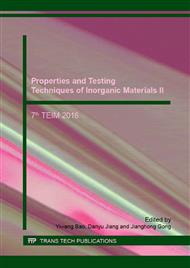p.13
p.18
p.23
p.28
p.33
p.38
p.43
p.50
p.55
Characterization of Test Methods of Capillary Pressure of Cement-Based Materials
Abstract:
A Negative pressure sensing set-up for capillary pressure test was designed and used for testing the capillary pressure of cement-based materials, cement pastes of water-cement ratio 0.30 was adopted, and the factors that may affect the measured values such as hardness of water tube, gas volume in the set-up, gas content in water, test depth, bleeding of cement pastes was studied. The results shows that the accuracy of the measured value is very large impacted by the air volume in the set-up and by the hardness of water tube, the capillary pressure at different depths could be affected by the external environment and the bleeding of cement pastes. According to the test results, methods for measuring the capillary pressure of cement-based materials were proposed, and some other recommendations that help to improve the test accuracy were given.
Info:
Periodical:
Pages:
33-37
Citation:
Online since:
January 2017
Authors:
Keywords:
Price:
Сopyright:
© 2017 Trans Tech Publications Ltd. All Rights Reserved
Share:
Citation:


